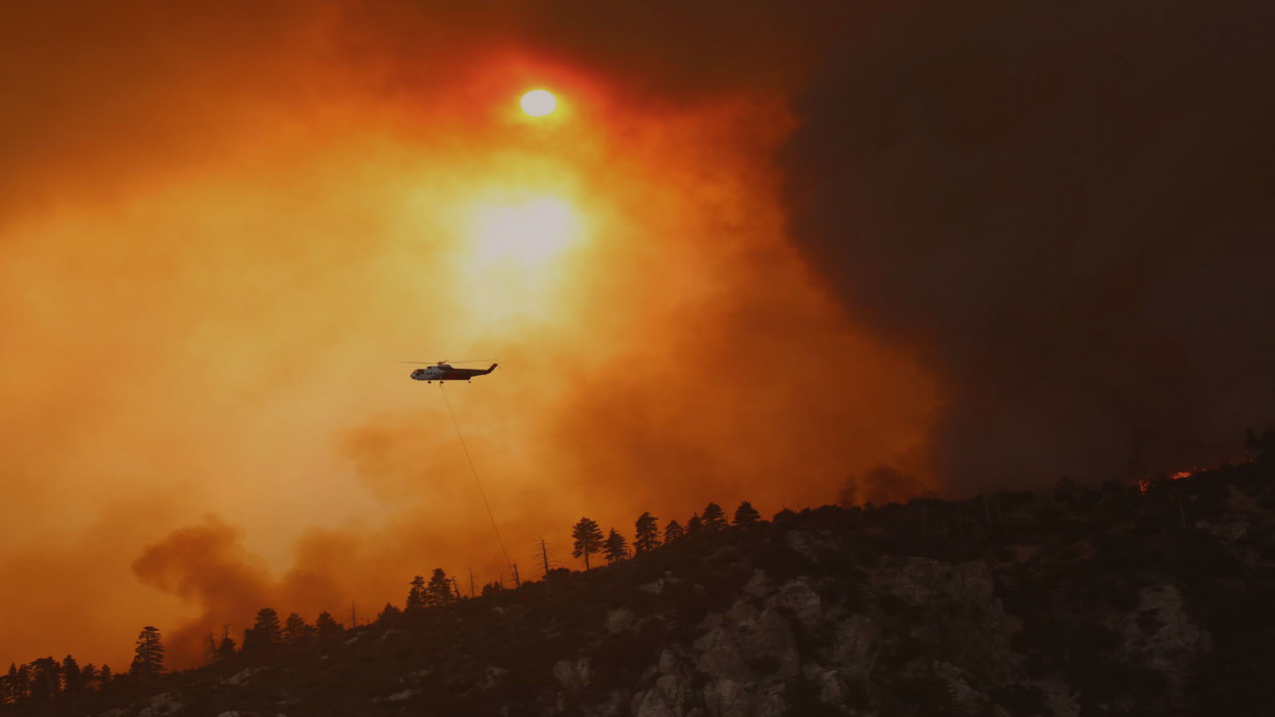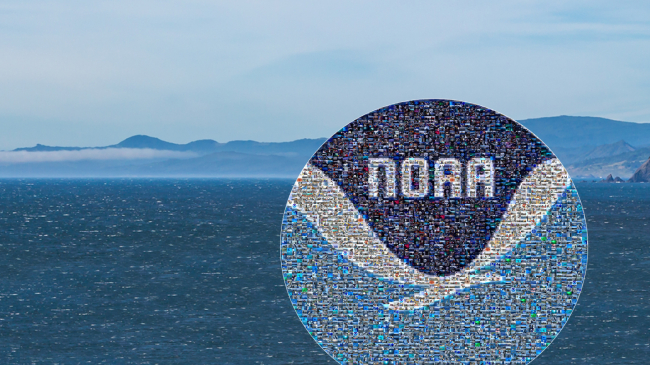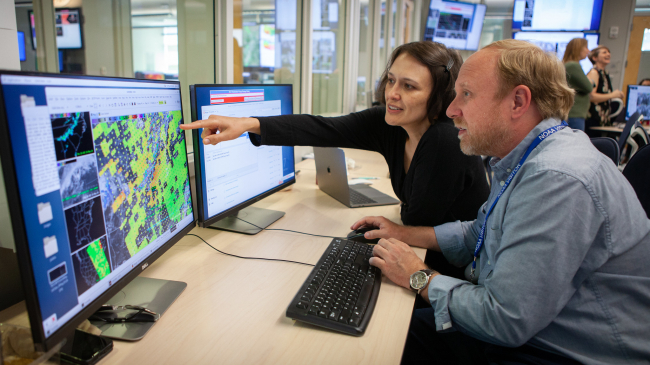
The Bobcat Fire started in and around Angeles National Forest in California on September 6, 2020. As of October 5, 2020, the fire had burned through more than 115,000 acres. In this Inciweb photo, a helicopter flies over a portion of the fire to help extinguish it. More information and photos available at Inciweb, www.inciweb.nwcg.gov. (Image credit: Inciweb, inciweb.nwcg.gov)
Fire managers and residents of the western U.S. will be on edge as a relentless drought and episodes of extreme heat — caused by short-term weather and longer-term climate change — increase the likelihood that natural or human-caused ignitions will bring a long wildfire season across the bone-dry landscape.
NOAA plays a vital role supporting federal, state, local and tribal partners in preparing for the threat of wildfires and in battling the blazes that endanger life and property. NOAA's forecast products range from short-term warnings to long-term seasonal predictions, and include air quality and smoke forecasts related to wildfires. NOAA also provides real-time fire and smoke detection tools using new imaging capabilities from geostationary and polar orbiting satellites.
NOAA's FY23 budget request includes $4,000,000 for fire product research, development, transition and maintenance. NOAA is pursuing a series of short-term and long-term fire product development activities, including demonstrating fire detection and characterization products and alerting systems in the NOAA Fire Weather Testbed that address critical gaps in the fire product lifecycle.
Where to start? Visit our new web hub, noaa.gov/wildfire.
Learn more about NOAA’s fire weather science and products below.
Monitoring and forecasting
Drought is an underlying condition that enhances the risk of wildfires. NOAA experts contribute to the National Drought Mitigation Center’s Weekly Drought Monitor offsite link, which shows the extent and severity of the current drought and maintains a record of drought statistics that show trends.
High temperatures, low humidity, wind and lightning from dry thunderstorms are weather conditions that can help spark a blaze — as can human activities. Forecasts for environmental conditions that can enhance wildfire development are available on a timescale from daily to subseasonal from NOAA’s National Weather Service:
- Check Weather.gov for the latest Fire Weather Watches and Red Flag Warnings where fire danger is most immediate. Air Quality Alerts, issued in part for unhealthy levels of smoke, are generated by local authorities and relayed by local NWS offices.
- Long-range outlooks for conditions conducive for wildfire development are available through the next week, throughout the current month and seasonally for the next three months.
- And learn how to prepare for wildfires with the NWS Weather Ready Nation program. FEMA's Ready.gov also has great wildfire preparedness tips.
NOAA satellites are on continuous watch for hotspots that indicate new fire starts and fire growth — offering valuable early warning and monitoring support for responders and incident managers, especially when ignitions occur in less-populated areas. Satellites also provide extensive data about soil moisture and vegetation health, which can be precursors to fire risk.
- NOAA satellites can detect new fires and hotspots, monitor existing fires and the smoke they generate.
- NOAA’s Active Fires Product maps the location of current wildfires around the globe as seen from our satellites.
For forecast products, contact: nws.pa@noaa.gov
For satellite imagery of current or past wildfires, contact: nesdis.pa@noaa.gov
Supporting wildfire incident management
NOAA deploys Incident Meteorologists (IMETs) to wildfire incident command posts at the request of emergency managers. These specially-trained and equipped forecasters work closely with incident commanders to provide highly-detailed and tactical forecasts that support operational decisions that enable firefighters to safely combat wildfires. Follow the IMETs on Twitter and Facebook.
NOAA is a proud partner of the National Interagency Fire Center, which produces a National Significant Wildland Fire Potential Outlook every month, and reports current and historical national statistics on large fires, wildfires acres burned — among their wide range of services related to wildland firefighting.
For information on NOAA’s IMETs, contact: nws.pa@noaa.gov
NOAA fire weather research
NOAA’s fire research activities range from improving long-range seasonal and subseasonal predictive tools that provide early indications of drought extent and severity, through advancing the skill of short-range models that identify changes in weather that alter fire behavior, to post-fire runoff and flood forecasts.
Using observations and satellite assets, NOAA scientists develop products that address public safety risk and vulnerability, and pioneer systems that provide advanced decision support to officials managing fires and their impacts:
- NOAA researchers are investigating how ocean conditions can influence precipitation patterns thousands of miles away, leading to improved predictability of fire risk on timescales of weeks to months.
- NOAA’s drought early warning tools can help predict conditions that lead to rapid loss of moisture to the atmosphere from soil and vegetation — increasing risk of ignitions and fire growth.
- High-resolution weather models developed by NOAA scientists predict how weather will influence fire growth, and how smoke from fires will spread locally and across the nation.
- NOAA scientists are developing a state-of-the-art precipitation and flood-forecast system to help officials manage the effects of extreme rainfall and post-fire flooding caused by atmospheric rivers.
To connect with experts on fire weather research, contact: Theo Stein, theo.stein@noaa.gov
Climate change connection
NOAA tracks long-term changes in our atmosphere and climate that influence wildfire frequency and severity — a topic that is included in the National Climate Assessment, produced every four years and for which NOAA is the lead federal science agency.
In the Fourth National Climate Assessment, a review of the most up-to-date science found that climate change is altering forested ecosystems and their function through major shifts in vegetation type and extent, resulting in an increase of the area burned by wildfire. Recent field studies have found even stronger links between drought, tree mortality and an increase of fire on the landscape outside of natural cycles, with much of the research pointing to human-caused climate change.
With continued high emissions of greenhouse gases, models project that the risk of very large wildfires will increase by up to six-fold in parts of the United States by mid-century. At high latitudes, including in Alaska, warming has already made forest fire fuels more flammable.
Discover more about the influence of climate change on wildfires through the Desert Research Institute, which hosts NOAA's Western Regional Climate Center offsite link and operates the Wildland Fire Science Center offsite link.
Throughout the fire season, the Event Tracker on NOAA's Climate.gov provides information about the climate conditions behind selected high-profile fire events.
For information on wildfires and climate, contact: Theo Stein, theo.stein@noaa.gov



